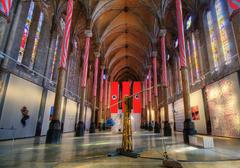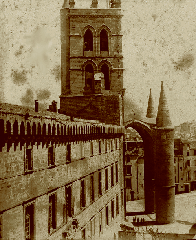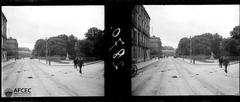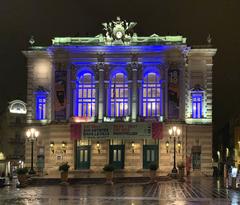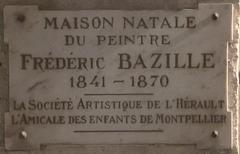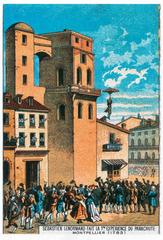Protestant Cemetery Montpellier: Visiting Hours, Tickets, and Historical Sites Guide
Date: 04/07/2025
Introduction
The Protestant Cemetery of Montpellier is a profound emblem of the city’s rich religious history and enduring Protestant heritage. Established in 1809 under a decree by Napoleon I, it is not only Montpellier’s oldest active Protestant burial ground but also a powerful testimony to the resilience, cultural identity, and social integration of Protestant communities in southern France. As a city, Montpellier emerged as a key center of the Reformation in the 16th century, experiencing both religious turmoil and coexistence that shaped its urban and social fabric. The Protestant Cemetery’s origins and evolution mirror these historical dynamics, serving today as a serene and evocative site that invites exploration by historians, genealogists, and travelers alike (Wikipedia; World History Encyclopedia; Patrimoines du Sud).
Table of Contents
- Establishment and Development of the Cemetery
- Architectural and Artistic Features
- Historical and Social Significance
- Visiting the Cemetery: Hours, Tickets, and Accessibility
- Visitor Etiquette and Practical Tips
- Notable Burials
- Nearby Attractions and Cultural Itineraries
- Group Visits and Guided Tours
- Frequently Asked Questions (FAQ)
- Contact Information
- Sources and Further Reading
Origins and Early Protestant Presence in Montpellier
Montpellier’s Protestant Cemetery is rooted in the city’s pivotal role during the Reformation. By the mid-16th century, Montpellier was a significant Huguenot center, with Protestants comprising a growing share of the population—especially among university students and faculty. Protestant influence peaked after the Edict of January 1562, which granted religious tolerance (World History Encyclopedia). However, this era was turbulent, with the city oscillating between Protestant and Catholic control during the Wars of Religion. After the Edict of Nantes (1598) provided for Protestant rights, Montpellier retained its Protestant character until its autonomy was curtailed following the 1622 siege by royal forces.
Establishment and Development of the Cemetery
The Protestant Cemetery as it stands today is the fourth such burial ground for the city’s Protestant community. Created in 1809 by imperial decree, the cemetery was established to provide a legal, dedicated burial space for Protestants, following centuries of exclusion and clandestine burials (Wikipedia; Patrimoines du Sud). The site expanded several times in the 19th and early 20th centuries, reaching its current triangular layout and approximately 1.5 hectares in size.
Key milestones:
- 1809: Official founding with first burial.
- 1824, 1856, 1880, 1923: Subsequent expansions.
- 1880: Construction of the entrance chapel—now a site landmark.
Its continued use and preservation make it the oldest surviving Protestant cemetery in Montpellier, predating the city’s main communal cemetery, Saint-Lazare (Patrimoines du Sud).
Architectural and Artistic Features
The cemetery is notable for its triangular layout and understated funerary art, reflecting Protestant values of simplicity, humility, and equality. Monuments are typically modest, with plain gravestones, family enclosures, and inscriptions emphasizing personal faith rather than elaborate religious iconography (Patrimoines du Sud). The 19th-century entrance chapel, military memorials, and the well-preserved pathways and enclosures offer a unique perspective on Protestant funerary traditions (museeprotestant.org).
Artistic highlights:
- Chapel: Built in 1880, serves as a focal point.
- Military section: Marked by chains, artillery shells, and a WWI memorial portico.
- Family plots: Such as the Castelnau enclosure, illustrating lineage and community ties.
- Botanical diversity: Cypress and Mediterranean flora provide a tranquil setting.
Historical and Social Significance
The cemetery’s creation was a direct response to centuries of religious exclusion. After the revocation of the Edict of Nantes in 1685, Protestants faced bans on public worship and burial, with earlier cemeteries destroyed or repurposed. The current cemetery thus stands as a symbol of resilience and the gradual acceptance of religious minorities, mirroring the broader secularization and religious pluralism in 19th-century France (Patrimoines du Sud).
Unlike most French cemeteries laicized under the Third Republic, the Protestant Cemetery remained under the administration of the local Reformed Church, preserving its confessional character and serving exclusively the Protestant community (Patrimoines du Sud).
Visiting the Cemetery: Hours, Tickets, and Accessibility
Opening Hours:
- Generally open daily from 8:00 AM to 6:00 PM (extended to 8:00 PM in summer).
- Some sources specify Monday to Saturday, 9:00 AM to 5:00 PM—always confirm current times via the official website.
Admission:
- Entry is free; donations for site maintenance are welcome.
Accessibility:
- Main pathways are paved and wheelchair accessible, but some historic sections may have uneven ground.
- For visitors with special needs, contact the cemetery office in advance for assistance.
Location:
- Address: 1 Avenue de Palavas or 3 Avenue de Palavas, 34070 Montpellier.
- Accessible by tram (Line 3, “Place Carnot”) and bus routes.
Visitor Services:
- Information and tour arrangements at “Le Voltaire,” 3 Avenue de Palavas, during limited office hours or by appointment (montpellier.epudf.org).
Visitor Etiquette and Practical Tips
- Dress code: Modest, respectful attire is required, especially during memorial services (GraveListing).
- Conduct: Maintain quiet, reflective behavior; silence mobile phones; avoid recreational activities (TimeStoneMonument).
- Photography: Permitted for personal use; avoid photographing mourners or ceremonies (museeprotestant.org).
- Respect: Do not disturb graves, flowers, or memorials. Use main paths and do not step on burial plots.
- Weather: Summers are hot; bring water, wear sunscreen, and dress appropriately (TimeTravella).
- Prohibited: No pets (except service animals), picnics, littering, or loud music.
Notable Burials
The cemetery is the resting place of many figures who contributed to Montpellier’s development in medicine, academia, and civic life, such as François Delmas (mayor), university professors, and local dignitaries. The diversity of burials reflects the broad social spectrum of the Protestant community (Patrimoines du Sud; Find a Grave).
Nearby Attractions and Cultural Itineraries
Enhance your visit by exploring nearby sites:
- Saint-Pierre Cathedral: Gothic architecture and Protestant history (Diego en France).
- Jardin des Plantes: France’s oldest botanical garden, founded in 1593.
- Promenade du Peyrou: Iconic city viewpoint and park.
- Place de la Canourgue and Musée Fabre: Cultural and historical landmarks.
The cemetery’s central location makes it a key stop on any cultural itinerary.
Group Visits and Guided Tours
- Guided tours: Occasionally organized by local historical societies or during heritage events such as the European Heritage Days (Journées Européennes du Patrimoine).
- Group etiquette: Groups are welcome if respectful; children should be supervised and calm. Large groups should arrange visits in advance (montpellier.epudf.org).
Frequently Asked Questions (FAQ)
Q: What are the visiting hours?
A: Typically 8:00 AM–6:00 PM daily (may extend to 8:00 PM in summer). Confirm on the official website.
Q: Is there an admission fee?
A: No, entry is free; donations are appreciated.
Q: Are guided tours available?
A: Yes, especially during heritage events and by prior arrangement.
Q: Is the cemetery wheelchair accessible?
A: Main paths are accessible; some older areas may be uneven.
Q: Can I take photographs?
A: Personal photography is allowed; respect privacy and refrain from photographing ceremonies.
Q: Are pets allowed?
A: Only service animals permitted.
Q: What’s the best time to visit?
A: Early mornings or late afternoons on weekdays are quietest.
Contact Information
- Address: “Le Voltaire,” Apartment 39, 3 Avenue de Palavas, 34070 Montpellier
- Telephone: +33 4 67 65 82 93
- Official website
Office hours are limited; plan ahead for special requests or guided tours.
Conclusion
The Protestant Cemetery of Montpellier is a vital cultural landmark, encapsulating centuries of religious history, social transformation, and community resilience. As a rare example of a confessional urban cemetery, it offers invaluable insights into the lives and legacies of Montpellier’s Protestant families and stands as a living testament to religious diversity and perseverance. With free admission, central location, and proximity to other major attractions, it is an essential destination for visitors keen to understand Montpellier’s layered past. Plan your visit thoughtfully, observe respectful etiquette, and take the opportunity to explore the city’s broader historical tapestry.
For further information and updates, consult the Montpellier City Hall, museeprotestant.org, and Patrimoines du Sud.
Sources and Further Reading
- Protestant Cemetery of Montpellier, Wikipedia
- Montpellier during the French Reformation, World History Encyclopedia
- Protestant Cemetery of Montpellier: History, Cultural Significance, and Visitor Guide, Patrimoines du Sud
- Le Cimetière Protestant de Montpellier, Musée Protestant
- Protestant Cemetery of Montpellier Visitor Guide, montpellier.epudf.org
- Cemetery Etiquette, GraveListing
- Cemetery Etiquette: Dos and Don’ts, TimeStoneMonument
- Montpellier City Hall
